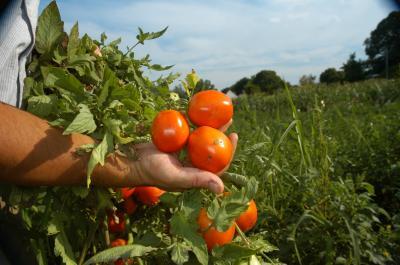If you have been to a tomato farm, you know that commercial tomato plants have a very different look from the backyard garden variety. Rather than being tall and lanky plants, tomatoes that will be canned for sauces and juice are harvested from plants that stop growing earlier than classic tomato varieties and are more like bushes. The architecture of these compact bushy plants allows mechanical harvesters to reap the crop, but the early end of growth means that each plant produces fewer fruits than their home garden cousins.
Genetics may bring the best of both worlds. Since the early 1900s, farmers have understood the concept of hybrid vigor, a property of plant breeding that has been exploited to boost yield. Without that and similar genetic optimization, tomatoes would be the size of a human thumb and not be juicy. First identified at Cold Spring Harbor Laboratory by George Shull in 1908, hybrid vigor – or heterosis, as biologists call it – involves interbreeding genetically distinct plants to generate offspring more robust than either inbred parent. It has been used for decades to improve agricultural productivity, but scientists have long debated how and why it works.
Modern Cold Spring Harbor Laboratory
researchers have now announced that they have determined a genetic mechanism for hybrid vigor. Teasing out the hidden subtleties of a type of hybrid vigor involving just one gene has provided the scientists with means to tweak the length of time that bushy tomato varieties can produce flowers. In these plants, longer flowering time substantially raises fruit yield.
In previous work, CSHL Associate Professor Zach Lippman and Israeli colleagues identified a rare example of hybrid vigor involving a genetic defect in the gene that makes florigen, a hormone that controls the process of flowering and flower production. The mutation dramatically increases tomato yields in bush tomatoes, and Lippman and his team, led by postdoctoral researcher Ke Jiang, set out to understand the mechanism behind this remarkable result.

A mutation in the hormone that controls flowering postpones when a plant stops producing flowers, yielding many more fruits. Credit: Cold Spring Harbor Laboratory
They found that bushy plants with a mutation in one of the two copies of the florigen gene, producing half as much florigen as plants without the mutation do, postpone the moment when they stop producing flowers. This, in turn, leads to many more fruits overall. "This is because," Lippman explains, "bushy tomato varieties are highly sensitive to the amount, or dosage, of the florigen hormone, which alters plant architecture – that is, how many flowers can form before growth ends. These discoveries lead to an exciting prediction: that it may be possible to tweak florigen levels to increase yields even further."
Lippman's team also studied florigen mutants in another plant, the crucifer weed known as Arabidopsis that is a cousin of crops like broccoli and cauliflower. Although they did not see the same increase in yield, they did observe similar changes in plant architecture because of florigen dosage sensitivities.
These results suggest that it may be possible to manipulate florigen in a wide variety of flowering species to increase yields.





Comments